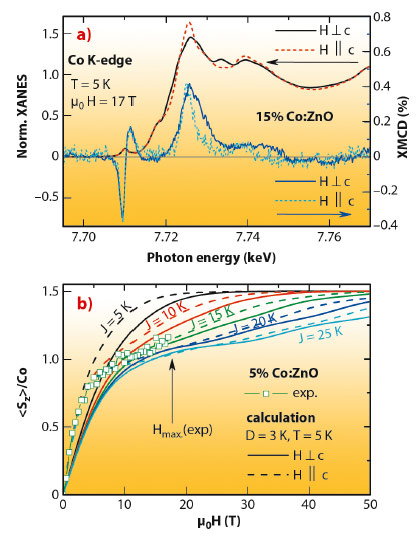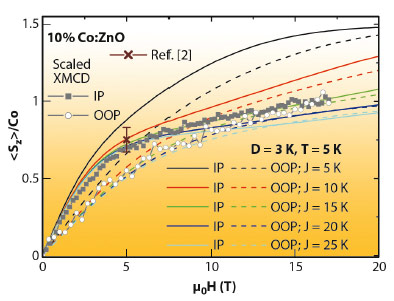- Home
- Users & Science
- Scientific Documentation
- ESRF Highlights
- ESRF Highlights 2012
- Electronic structure and magnetism
- Quantification of magnetic exchange in Co:ZnO via high-field XMCD magnetometry
Quantification of magnetic exchange in Co:ZnO via high-field XMCD magnetometry
Dilute magnetic semiconductors (DMS) are envisioned as sources of spin-polarised carriers for future semiconductor devices which simultaneously utilise spin and charge degrees of freedom. Zn1-xCoxO (Co:ZnO) has been thought to be a promising DMS material. Paramagnetic Co2+ impurities in ZnO single crystals have been studied already fifty years ago and a model Hamiltonian for the 3d7 (i.e. S = 3/2) impurity is well-established including a single ion anisotropy DSz2 to account for the anisotropy of the wurtzite host crystal [1]. Most DMS Co:ZnO samples contain Co concentrations at or above 5% so that the next-cation-neighbour exchange J of Co-O-Co pairs comes into play as well. It has already been indirectly inferred that J is antiferromagnetic [2], however direct evidence and quantification of its strength was lacking so far. To reach both goals, the magnetisation steps associated with a spin-flop transition were measured up to high magnetic fields to overcome the antiferromagnetic coupling.
Co:ZnO epitaxial films with 5% to 15% of Co grown by reactive magnetron sputtering onto c-plane sapphire [3] were studied with synchrotron radiation. X-ray absorption near-edge spectra (XANES) were recorded at beamline ID12 in total fluorescence yield using circularly polarised light under 10° grazing and normal incidence. The X-ray magnetic circular dichroism (XMCD) was recorded at the Co K-edge while reversing the polarisation as well as the magnetic field direction. Element selective XMCD(H) curves were measured up to high magnetic fields of 17 T for both principal orientations.
 |
|
Fig. 96: a) XANES spectra at the Co K-edge of 15% Co:ZnO recorded with circular polarisation under grazing and normal incidence at 5 K, and the respective XMCD spectra. b) XMCD(H) curve for 5% Co:ZnO under grazing incidence in comparison with model calculations (lines) for various coupling strengths J (see text). |
Figure 96a shows the XANES and respective XMCD spectra recorded at the Co K-edge of 15% Co:ZnO at 5 K under grazing and normal incidence, i.e. probing the Co-specific electronic and magnetic properties either perpendicular (H⊥c) or parallel (H||c) to the c-axis. The XANES is anisotropic, reflecting the uniaxial symmetry of the wurtzite lattice of Co:ZnO. The size of the resulting XLD can be associated with a substitutional incorporation of the Co into the ZnO host lattice [2].The XMCD at 17 T is virtually isotropic, in particular at the pre-edge feature, where 4p-3d hybridised Co2+ states are probed. At the photon energy of the maximum XMCD, Co-specific magnetisation curves were measured. Figure 96b displays an XMCD(H) curve for 5% Co:ZnO for H||c. To quantify J, the following procedure was used: The M(H) curves for H⊥c and H||c were calculated for isolated Co ions (singles), pairs (two S = 3/2 spins coupled by J) and triples separately using the effective spin Hamiltonian [1] and an isotropic, Heisenberg-like antiferromagnetic coupling strength J. The resulting M(H) curves were weighted by the relative abundances of singles, pairs and triples, assuming a statistical dopant distribution [2]. Figure 96b displays this calculation for various values of J/kB from 5 K to 25 K and a fixed value of D/kB = 3 K [3]. The best agreement between experiment and simulation is reached for J/kB = 15 K for the 5% Co:ZnO sample. Figure 97 shows the respective analysis of the XMCD(H) curves for H⊥c and H||c of the 10% Co:ZnO sample yielding J/kB = 15 K. In this case, D/kB was also varied from 2 K to 4 K (not shown) with D/kB = 3 K as best fit, which is in agreement with the SQUID analysis in [3]. The quantitative analysis of SQUID data from [2] also fits the XMCD(H) curve well (cross in Figure 97). An identical analysis for the 15% Co:ZnO sample yields a reduced J/kB = 10 K and D/kB = 2 K (not shown). The reduction of J and D at higher Co concentrations may be understood by an increasing contribution from larger dopant configurations.
 |
|
Fig. 97: XMCD(H)-curves of 10% Co:ZnO for H |
In conclusion, we could determine the antiferromagnetic coupling strength J and the single ion anisotropy D in Co:ZnO by element selective, high-field XMCD-magnetometry to be J/kB = 15 K and D/kB = 3 K for 5% and 10% of Co which are both reduced for 15% Co doping to J/kB = 10 K and D/kB = 2 K. These findings allow direct quantification of magnetic interaction parameters of DMS materials and open up the possibility of estimating the success of changes of the magnetic interactions in DMS systems upon co-doping or external parameters like electrical field, current or stress.
Principal publication and authors
A. Ney (a), V. Ney (a), F. Wilhelm (b), A. Rogalev (b) and K. Usadel (a), Phys. Rev. B 85, 245202 (2012).
(a) Experimentalphysik, Universität Duisburg-Essen, Duisburg (Germany)
(b) ESRF
References
[1] T.L. Estle and M. de Wit, Bull. Am. Phys. Soc. 6, 445 (1961); P. Koidl, Phys. Rev. B 15, 2493 (1977).
[2] A. Ney, K. Ollefs, S. Ye, T. Kammermeier, V. Ney, T.C. Kaspar, S.A. Chambers, F. Wilhelm, and A. Rogalev, Phys. Rev. Lett. 100, 157201 (2008).
[3] A. Ney, T. Kammermeier, K. Ollefs, S. Ye, V. Ney, T.C. Kaspar, S.A. Chambers, F. Wilhelm and A. Rogalev, Phys. Rev. B 81, 054420 (2010).
 c (IP) and H||c (OOP) at 5 K in comparison with model calculations to determine the coupling strength J.
c (IP) and H||c (OOP) at 5 K in comparison with model calculations to determine the coupling strength J.


